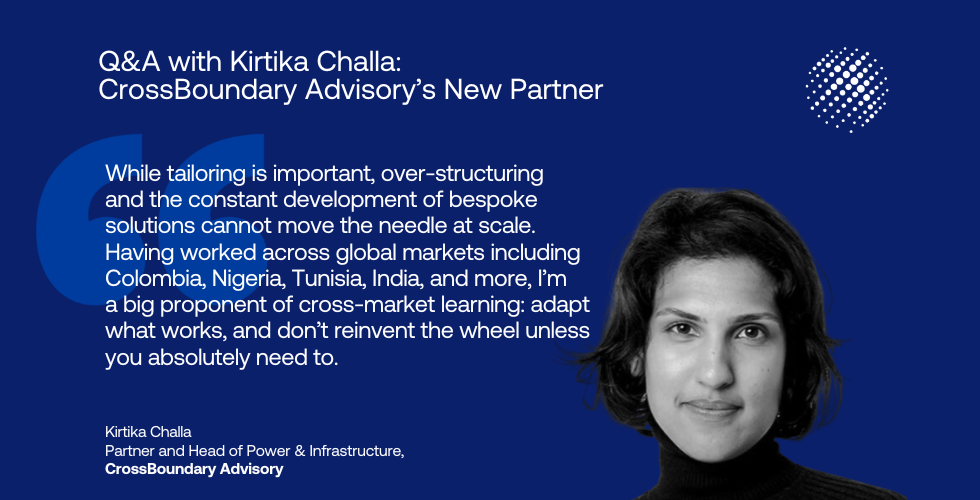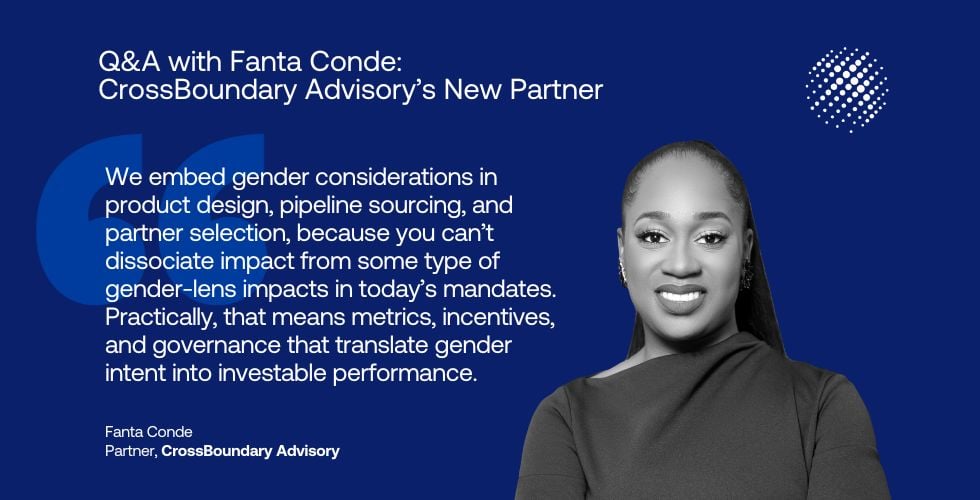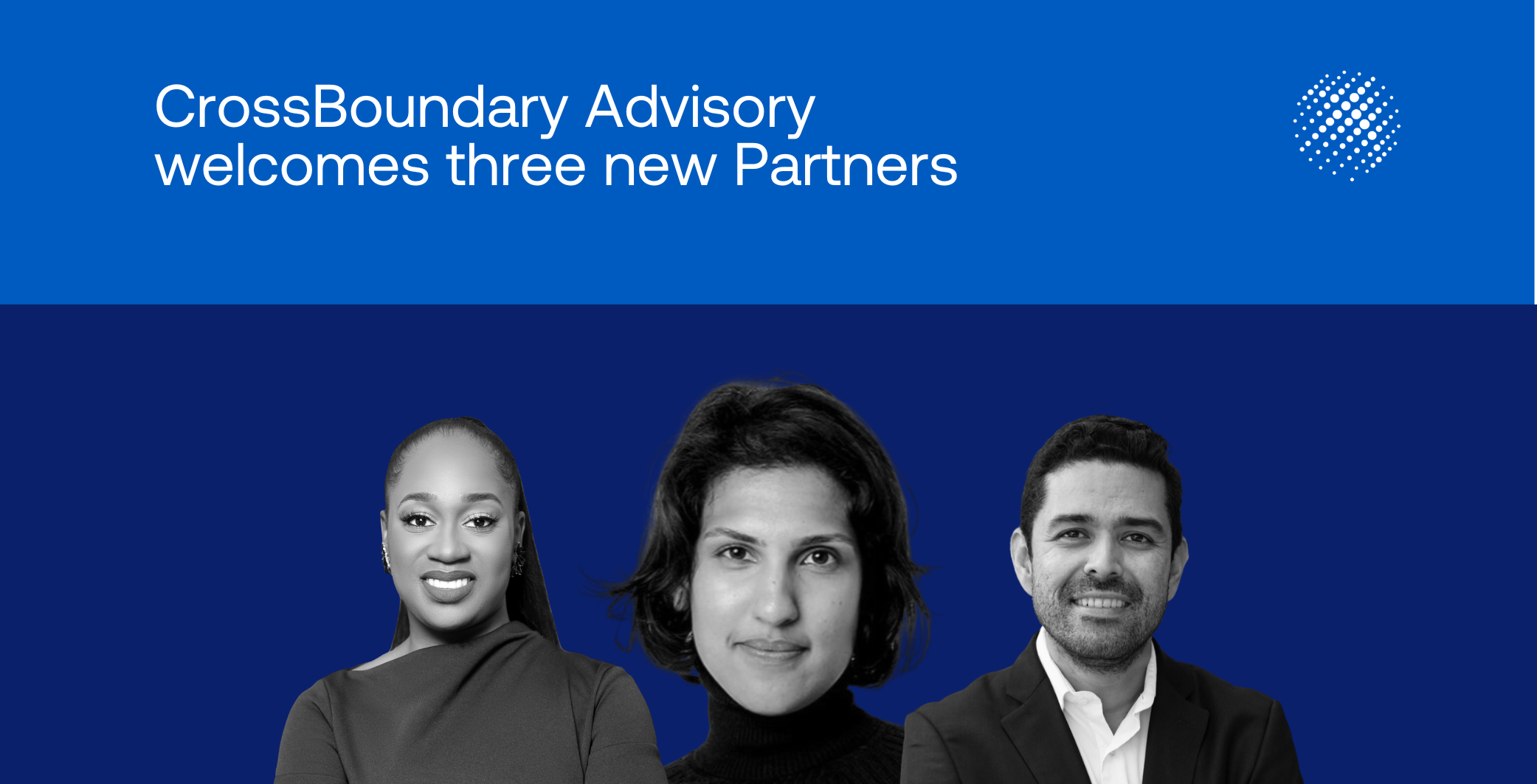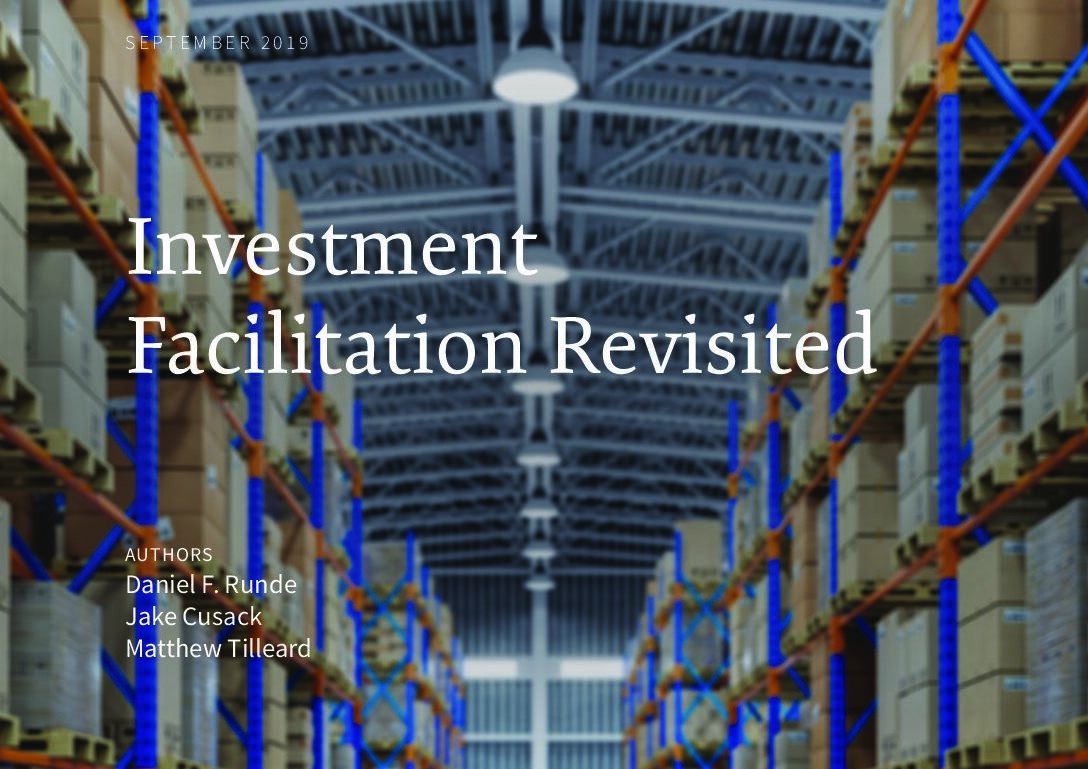
Q&A with Kirtika Challa, CrossBoundary Advisory’s New Partner
CrossBoundary Advisory recently announced three new partners to lead our growing investment advisory practice.
CrossBoundary Advisory recently announced three new partners to lead our growing investment advisory practice.
Kirtika Challa, Fanta Conde, and Jonathan Duarte will join Partners Jake Cusack, Thomas Flahive, and Paul Ouma in the leadership of CrossBoundary Advisory. Each new partner brings unique expertise and perspectives in the specific geographies and sectors they serve.
We asked Kirtika Challa to reflect on her career and journey thus far and the opportunities she sees on the horizon for our clients, investors, and CrossBoundary Advisory as a firm.
Q: Your CrossBoundary story is a bit unusual: from Lagos to Tunis to a global sector lead. How did that path shape your view of talent and firm-building at CrossBoundary Advisory?
Kirtika: I joined CrossBoundary Advisory following experience in structured and corporate finance at Morgan Stanley. While I enjoyed the financial rigor and training I received there, I was missing a sense of more tangible impact in the real world, which is what led me to focus on emerging markets. I felt that I had the potential to make a more sizeable difference by addressing fundamental problems, like infrastructure, access to energy, and access to finance.
I was the 50th person to join the firm back in 2018, when the CrossBoundary name was perhaps not as well known. While participating in several recruitment processes at business school, what really stood about CrossBoundary’s approach was the firm’s focus on core values and strengths rather than years of experience. CrossBoundary was more interested in investigating my motivation, problem-solving skills, and ability to work hard and take full ownership rather than just indexing on if I had done the job before. While interviewing for a role in Lagos, the firm’s leadership were able to see spikes in my ability and willing to take a bet on me.
That approach to recruiting has held up across roles and markets as we have grown and our brand awareness has also grown. Following my time in Nigeria, I had the opportunity to establish CrossBoundary Advisory’s presence in North Africa, opening our office in Tunisia, and later stepped in to lead the Power & Infrastructure (P&I) advisory practice.
Through my experience across several roles and hiring at least 20 people since joining, I’ve learned that what makes CrossBoundary an exciting place to work is the people. And we have such great people because we prioritize builders who learn fast, are value-aligned, believe in the mission, and are excited to work hard for lasting impact.
The firm has changed dramatically since I joined—we’ve grown from 50 people across 5 offices to 250+ across more than 25. I no longer know what everyone is doing day-to-day, which shows just how much we’ve scaled. This growth has been an exciting journey to be part of, and as a Partner, I’m committed to ensuring it remains a source of strength. We must preserve our interconnectedness, shared consciousness, and collaborative spirit across all offices and platforms as these are the qualities that will continue to enable us to have a lasting impact in the world.

Q: How has the infrastructure investment landscape in underserved markets evolved since you began leading CrossBoundary’s Power & Infrastructure practice? What are you seeing emerge or take hold in 2025, compared to previous years?
Kirtika: The biggest trend I have seen over the last decade is that energy transition is no longer discussed as a tradeoff between sustainability and cost. We are finally seeing clear cost parity for several clean energy technologies that now represent the cheapest way to generate electricity in many parts of the world.
Secondly, we are starting to see a shift from focusing on just energy access, to focusing on how do leverage this energy infrastructure to drive increase in income generation. As the backbone of the energy infrastructure gains momentum, layering on digital infrastructure, connectivity, and productive use of energy to drive income generation and the commercial viability of the energy and infrastructure is a growing theme. This includes collaborating with a wide range of energy hungry industries like industrial processes, critical minerals, and data centers.
Finally, and a more recent trend – with shrinking overseas development assistance (ODA), the sustainability of interventions matters more than ever. Capital is gravitating toward models with clear paths to commercial viability, often anchored in economic corridors and hubs rather than standalone assets. And blending various sources of capital to make the limited donor dollars go further continues to be a growing, and increasingly mainstream concept.
Q: Where is capital underweighted today?
Kirtika: I am still seeing capital overweight on supply: generating new megawatts while there continues to be persistent under-investing in demand, and the infrastructure that actually delivers power. On the demand side, we need more focus on commercial use and applications, alongside energy efficiency, and on the infrastructure side, we also need to invest in transmission and distribution networks, and the market systems that enable power to flow more efficiently.
A key opportunity is also optimizing between centralized and decentralized solutions while also increasing cross-border energy trading through regional power pools. Get that right, and you unlock much better system economics.

Q: How can corporate partnerships accelerate our impact priorities?
Kirtika: Many large corporates already operate deep distribution, logistics, and service networks across food & ag, consumer goods, tech, and transport, like Dangote in Nigeria; Tatas, Birla in India; and FEMSA in Mexico. Rather than rebuilding those channels from scratch, pair impact priorities with established corporate infrastructure and use flexible foundation capital to offset the “additional” costs. It can allow for a faster, cheaper route to scale, which is particularly important today when concessional capital is limited.
Q: How can blended finance be used to enable more infrastructure development and investments in markets that traditional capital might consider too risky?
Kirtika: The key goal with blended finance is to use the right tool for the right problem. e.g. utilizing Viability Gap Funding (VGF) to balance viability and access; repayable grants to finance early stage development; guarantees to address risk perception; and subordinated or first-loss capital to increase risk tolerance – and where possible use blended finance instruments to mobilize additional capital and think about how we can also phase out that concessionality as return and performance is proven out.
And importantly, these structures only work if they solve the real barriers to capital, which means the capital you are trying to mobilize needs to be engaged from the get-go. Too often, you see pre-baked solutions with unnecessary complexity, which ends up causing delays and unnecessary constraints, and makes the investment challenging for capital allocators. While tailoring is important, over-structuring and the constant development of bespoke solutions cannot move the needle at scale. Having worked across global markets including Colombia, Nigeria, Tunisia, India, Philippines and more, I’m also a big proponent of cross-market learning: adapt what works, and don’t reinvent the wheel unless you absolutely need to.

Q: What are some common mistakes that private investors make when evaluating infrastructure opportunities in underserved markets?
Kirtika: One mistake is assuming there’s a lack of willingness to pay. People are already paying for diesel or lamps, but affordability thresholds matter. There’s also a tendency to over-index on country risk instead of focusing on the specific business or sector risks that actually matter.
Another common error is undervaluing local developers who understand how to work with government and other stakeholders, especially landowners and community leaders. Similarly, investors often underestimate the role of government and policy change. We see repeatedly how elections and regulatory changes can materially affect projects.
Finally, it’s hard to build for a future that doesn’t yet exist – you are either going to be under or over capacity – and so investing according to a broader thesis rather than a single asset is a way not only to diversify but also enable your asset to succeed.



